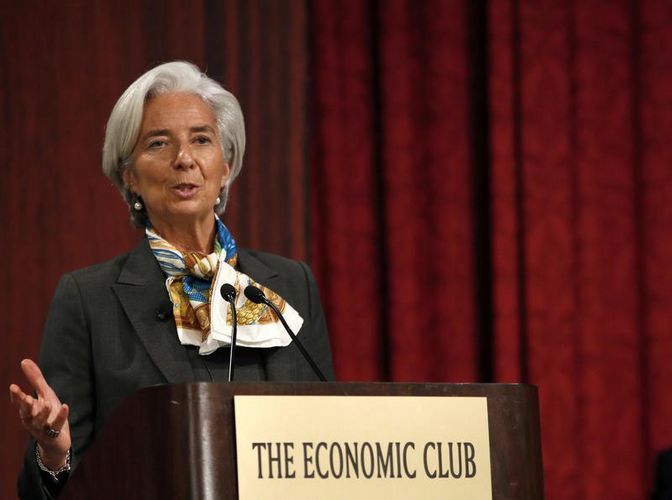
IFR Editor-at-large Keith Mullin
But still… I thought her references to the ’oversize banking’ model of too-big-to-fail being more dangerous than ever; derivatives as “the dark matter of the financial system”; shadow banking “still a shady corner toward which risk appears to be gravitating”; and “pre-crisis banking in a post-crisis world” were all mightily strange and rather passé in light of developments over the past couple of years.
OK, she’s certainly right to say that the actions of policymakers have rendered the economic world less dangerous than it was six months ago. She’s also right to low-ball the economic growth outlook. But in moaning at the same time that “improvements in financial markets have not translated into improvements in the real economy” – by which I assume she means more bank lending – she’s missing some key points.
Better financial markets rarely lead, in and of themselves, to improvements immediately or at all in the real economy, depending on the incentives at play. It’s often a matter of timing and the inevitable lag-effect. The current asynchronicity between the market and economic cycles is certainly straining the correlation and this needs to be taken into account.
With comments like that, you wonder if she really understands investors or their motivations in the current rate cycle
Policymakers perennially drone on about what they see as the failure of transmission mechanisms as if it were a problem created by killjoy banks. This is only partly true and the blame game is becoming rather vexing. In fact, I reckon it’s is as much a problem created by policymakers wanting their cake and eating it as it is a matter of recalcitrant banks hoarding money.
At the base level certainly, the pullback in bank lending is symptomatic of the lack of growth expectations. Let’s be clear here: lending is one of the greatest and most proprietary forms of risk-taking banks engage in. Policymakers on the one hand want to force banks to lend; on the other hand they hammered them for inappropriate lending last time around (some of which was warranted, in fairness) and they’re browbeating them now to adopt a conservative stance in order to maintain solid capital cushions and avoid a build-up of bad loans in order to avoid systemic risk down the road.
For the banks, it’s a case of damned if they do, damned if they don’t.
A basic tenet of credit extension has to be the likelihood of repayment based on some semblance of growth as well as a stringent risk assessment of the borrower. The murky picture we’re confronted with now has to be reflected in either restricted credit or credit extension at elevated cost. I don’t say that based on some smart-ass money theory; isn’t it common sense?
And let’s not forget that it’s also partially about lack of demand at the client end. Business owners tell me they’re paying off their bank debt as fast as their industrious legs can carry them and they have no interest in taking on new indebtedness at a time of low growth and high unemployment where business prospects are grim. It’s not a case of the plumbing being clogged up, as Lagarde said.
Regulatory fragmentation
Beyond the economics, the lack of follow-through into the real economy is a direct response to the expensive, convoluted, misaligned and self-serving regulatory set-ups being implemented by policymakers across the world. Lagarde referenced this in her speech but didn’t expand on it: (“Financial sector reform efforts must also be co-ordinated internationally. We are already seeing countries pulling in different directions in some areas… We need more focus on consistent global regulation and implementation, including in key areas such as bank resolution”). To me this is a key point.
In fact, this theme is strongly pursued in the latest Morgan Stanley and Oliver Wyman Wholesale & Investment Banking Outlook 2013, Global Banking Fractures: the Implications, which coincidentally came out today. The report refers to regulatory fragmentation created by policymakers as the balkanisation of wholesale banking markets:
“We think the industry and the market have yet to get to grips with the forces fracturing global wholesale banking. In particular we now anticipate a 2-3% point drag on RoE from regulatory Balkanisation. While ring-fencing is getting a lot of attention, we see national subsidiarisation gathering pace quickly. With diverging national regulatory agendas, it poses a major risk to the global banking model …
“…The interplay of constraints imposed by host regulators in local markets, regulators in key hubs, and home market regulators creates an optimisation puzzle that is hard to solve. We estimate a total industry-wide RoE drag of 2-3% points, with limited scope for mitigation unless we start to see a more organised global policy response … Differing stances across jurisdictions of key policies including financial transaction taxes and bonus caps are likely to further fracture the global industry.”
More dangerous than ever?
At the same time as Lagarde bemoans the lack of lending to the real economy, she also reckons the ’oversize banking’ model of too-big-to-fail is more dangerous than ever. So while she supports the notion of shutting down banks where necessary, she also supports “direct recapitalisation by the ESM of troubled banks that have systemic implications”.
Are TBTF banks really more dangerous now than they were in that pre-Lehman period of rampant leverage, poor capitalisation, unbridled and irresponsible risk-taking, blind risk-modelling, heavy counterparty concentration, bad management, short-term compensation metrics, poor supervision and lax regulation? I hardly think so.
Referring to derivatives as “the dark matter of the financial system” was an unnecessarily emotional response.
The banking sector is much more robustly capitalised (albeit with some work still to do). The regulatory framework, while fragmented, has reined in banks’ tendency towards unbridled risk-taking and short-termism.
Banks have to hold a hell of a lot more capital in absolute terms. Punitive capital charges on certain products are having a fairly dramatic – but desired – effect on business selection and generally on RWA growth, while liquidity and leverage caps, caps on compensation; and efforts to route OTC derivatives through central counterparties have surely rendered the banking sector a safer place.
Lagarde’s comment that “we simply cannot have pre-crisis banking in a post-crisis world” came across as incongruous. I don’t think anyone can argue that’s what we have. She also referred to “intense pushback from an industry sometimes reluctant to abandon lucrative lines of business”. That dig similarly seemed a strange thing to say in light of the fairly dramatic reshaping that’s being going on for the past couple of years at an individual bank level as management focuses squarely on shareholder value and portfolio optimisation. Do banks lobby aggressively to have things watered down? Of course, but I think Lagarde is over-stating the case.
Her exhortation to “get to the root of the problem with comprehensive and clear regulation, more intensive and intrusive supervision, as well as frameworks for orderly failure and resolution – including across borders, and with authorities empowered to oversee the process” is all in process.
Bubble economics
Referring to derivatives as “the dark matter of the financial system” was an unnecessarily emotional response. Lagarde reckons shadow banking is “still a shady corner toward which risk appears to be gravitating” but I think of more concern is that risk is gravitating via large and increasingly leveraged capital flows to emerging markets and into risky and speculative areas of developed markets as the quest to generate yield obsesses investors as a direct corollary of massive monetary stimulus.
Lagarde supports the stance by major central banks (“in present circumstances, it makes sense for monetary policy to do the heavy lifting in this recovery by remaining accommodative”) but acknowledges the unintended consequences (“low interest rates push people to take on more risk – some of which justified, some of which not”.) I’m hearing ‘bubble’.
The IMF supremo acknowledged that a sudden reversal of large and volatile capital flows can bring economies down with them. “Right now, these risks appear under control,” she said. Hmmm. I’m not so sure. “Capital is flowing to emerging markets mainly because of good policies and good prospects in these markets,” she said. This is where we kind of part company.
With comments like that, you wonder if she really understands investors or their motivations in the current rate cycle. For sure, it’s partially correct but where specialist EM funds focus on bottom-up fundamentals, the generalist funds – which have been allocating ever-increasing portions of their portfolios to non-traditional areas like EM, high-yield etc – are less circumspect and have been piling in with abandon into areas of the capital markets they wouldn’t normally poke with a stick and where the risk-return is way out of kilter.
This is the archetypally dumb, follow-the-herd money that will get hurt when the smart money has checked out and when flows reverse – whether it be post-QE when yield curves in major markets normalise, or due to some unforeseen localised event.
Lagarde warned emerging markets to boost their defences. I doubt that EM economies – as ever – will all do what’s required to take account of the impact of future capital outflows.That’s a risk. And the dumb money will miss the signals and the laggards will be massacred. That’s another one.
Event-risk in speculative areas of the capital markets hasn’t gone away; it’s just in abeyance. Deflating bubbles is the issue deserving more air-time, in my view.
Think I’ll e-mail Christine.


